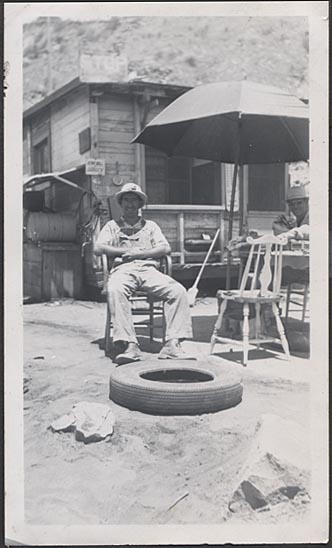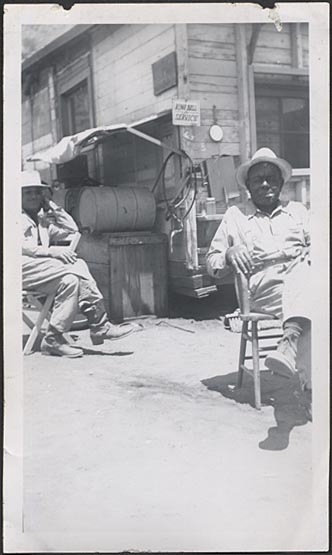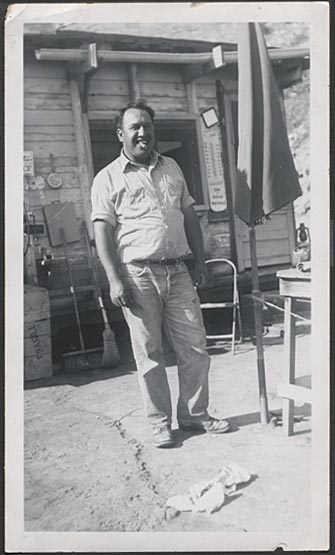Schwarz
View current page
...more recent posts
restore philly pa
'09 ponderosa stomp
daily yonder rural radio picks
rip archie green
Mr. Green, a shipwright and carpenter by trade, drew on a childhood enthusiasm for cowboy songs and a devotion to the union movement to construct a singular academic career. Returning to college at 40, he began studying what he called laborlore: the work songs, slang, craft techniques and tales that helped to define the trade unions and create a sense of group identity.
He countered the prevailing, somewhat romantic notion that folklore was isolated in remote, marginal groups, said Simon Bronner, who teaches folklore at Pennsylvania State University. He showed that each of us, in our own work lives, have a folklore that we not only perform but that we need.
At the same time, Mr. Green energetically promoted the idea of public folklore that is, that folklorists should work outside the academy to gather, preserve and publicize local cultures through government agencies, museums, folk festivals and radio stations. His signal achievement in this area was the lonely lobbying campaign he conducted for nearly six years to create a national folklife center, which became a reality when Congress, by a unanimous vote, passed the American Folklife Preservation Act, signed into law by President Gerald R. Ford in January 1976.
soul sides
funky 16 corners podcast archive
acme sliding door display
spring assortment
hose sample display
little records with big holes at the hound
This suggestion concentrates on the idea of allegory and appropriation. In Biro's paper 'Allegorical Modernism: Carl Einstein on Otto Dix', Biro reveals a critique of modernist painting as essentially, "appropriationist" [82] and "represententational" which is, needless to say, on an opposing platform to formalism. Biro's paper is specific to the history of the Weimar Republic in the 1920's and 30's and thus differs from Krauss in this respect. Krauss maps her Repressed Modernism across the twentieth century and the conclusion of 'Formless: A User's Guide' suggests how the informe might operate in current art. Biro's project, not being as extensive, leaves us with the task of applying his Allegorical Modernism to more recent practice. Nevertheless, Biro's methodology is similar to Krauss in that, through his analysis of Einstein's article on Dix, he has identified an alternative to formalist critique, not from a post-modern point of view but, like Krauss, from within modernist discourse during the 1920's and 30's. What is interesting here is that Bataille and Einstein were editors and main contributors to the short lived Parisian journal Documents, published during 1929 to 1930, the significance of which is of current concern.
hal-a-fuckin-lu-ya
Once hailed as a beacon of rebirth in the aftermath of the Sept. 11 terror attacks, the Freedom Tower's patriotic name has been swapped out for the more marketable One World Trade Center, officials at the Port Authority conceded today.thx drat
bach cantatas links non-vocal general articles
TUN3R online radio / video about
Discovering this album in a thrift-store was one of the most startling experiences of my record-hunting life. Hearing good ol' Johann Sebastian performed on the likes of snare drums, woodblocks and tom-toms had me completely bewildered. The New York Percussion Ensemble didn't cheat by using melodic percussion instruments like xylophones or marimbas - the list of instruments on the back include, apart from the ones I just mentioned, tambourines, cymbals, maracas, castanets, bongos, claves, triangle, cowbell, tympani, boobams, and sleigh bells.
The sound lies closer to traditional African music then to classical. To quote a Time magazine review: "The result has the effect of an X-ray photograph of a flower barely recognizable, eerie and oddly fascinating." We make available three of the album's four cuts - the first track, a version of "Toccata and Fugue in D Minor," had a nasty gouge in it, but don't worry, it wasn't as good as the other three tracks.
This was no joke. Arranger John Klein's credits on the back cover are extensive - an early classical training, numerous classical and pop credits, and authorship of a "monumental two-volume work entitled 'The First Four Centuries of Music.'" I have no idea what this means, though: "Mr. Klein has composed music for no less then 137 dramas for the United States Treasury Department NBC Transcription Series..."
RIP Popcorn Sutton
video
thx adman
american culture between the wars kalaidjian
The avant-garde, popular, and working-class texts that Walter Kalaidjian discusses in his new work attempt to revise episodes in American culture that together constitute what he calls "a neglected cultural history" (8). Concentrating on such supposedly marginal moments in American culture as the Russian Revolution, the Harlem renaissance, the radical experimentations of the L=A=N=G=U=A=G=E poets, and the popular interventions of feminism, Kalaidjian dexterously blurs the boundaries between high and low culture, politics and aesthetics, and academicism and popular forms. Kalaidjian's book is divided into five chapters, each of which is, in turn, nicely divided into subsections dealing with a more specific aspect of the theme that the chapter treats. The first chapter, entitled "Revisionary Modernism," discusses the role of transnationalism during the interwar years as a key episode in the shaping of American culture. Within the chapter, Kalaidjian pays particular attention to the influence of the Russian avant-gardes in the formation of a strong Marxist-socialist consciousness in America. The second chapter explores how various "subgroups," like the Chicago John Reed Club, the New Negro movement, and the politicized aesthetics of Diego Rivera, Hugo Gellert, and Louis Lozowick, among others, "signaled a communicative difference from the dominant ideological signs of American commodity culture" (61). The section on Diego Rivera is perhaps the best part of the whole book. Chapters 3 and 4 discuss feminist concerns and radical movements in poetry respectively. Kalaidjian places these two important contemporary movements vis-a-vis the economic, political, and social concerns that he claims inform these movements. The work of authors who tend to reclaim the mode of "cultural critique," whose political edge, Kalaidjian claims, "cuts through the semiosis of everyday life and goes to the heart of postmodern spectacle," is the concern of chapter 5. This chapter criticizes the postmodern emphasis on the disappearance of the "real" (263).
Kalaidjian's purpose is not, however, simply to subvert the traditional, learned critical paradigm. His text shows that in High Modernism, Eliot, Pound, and Stevens, for instance, cohabited with the Dynamo group of poets. Kalaidjian's conflation of such apparently dissimilar poetic modes is not aimed at privileging one over the other. He argues, correctly I believe, that a thorough understanding of the period should take into account both discourses, since frequently the existence of one can throw light onto the other. One commonplace of High Modernist criticism, for instance, is to focus on the ahistorical stance most of the canonical poets adopted. By centering their discursive practices on transcendental concerns, poets like Eliot and Stevens ignored the urgent economic conditions affecting the country. This kind of anti-High Modernist discourse proves futile because it does not move further from the figures it supposedly attacks. Anti-Eliot discourse is, as it were, still focused on Eliot. Kalaidjian pushes beyond this sterile and circular critical move and cleverly shows, for example, how Ben Matt recasts Hart Crane's mythic bridge into a more politicized language to accommodate The Bridge to the discourse of political criticism. Kalaidjian argues that this kind of poetry arose from the period's deep dissatisfaction with American culture's emphasis on an increasingly automated labor process. Thus the critical veneration of such ahistorical writers as Eliot and Pound parallels the fate of society where workers "found themselves increasingly alienated from ever more automated systems of production, engineered and administered by a new class of technological experts" (154). Sol Funaroff, similarly, in "What the Thunder Said: A Fire Sermon," rearticulates Eliot's transcendental and historically unspecific resolution of social disillusion by turning it into a "materialistic vision of international class revolt, linking the unrest of pre-revolutionary Russia to depression era America" (154). Kalaidjian's work thus uncovers a historical and cultural layer that the predominant critical mode in United States, with its emphasis on individual genius, as it were, has buried in forgetfulness. His work therefore forces the reader to understand that the work of literature is, whether we like it or want to admit it, always inescapably part of a social field.






rip eddie bo (new orleans pianist)
video
Various Artiststhx dave
The Art of Field Recording, Vol. 2
[Dust-to-Digital; 2009]
In November 2007, Atlanta's Dust-to-Digital Records released The Art of Field Recording, Vol. 1 , a sweeping, 4xCD collection of field recordings assembled by the folklorist and visual artist Art Rosenbaum. Rosenbaum's considerable personal collection (which spans a half-century, contains thousands of hours of tape, and is supplemented by Rosenbaum's own photographs, paintings, and drawings) demanded more than just four discs; Dust-to-Digital plotted a second volume in response. Vol. 2 follows the same basic organizing principle as its predecessor: The four discs are arranged by theme (Survey, Religious, Accompanied Songs and Ballads, Unaccompanied Songs and Ballads), and are comprised exclusively of field recordings, provoked and captured in living rooms, churches, front porches, backyards, graveyards, and parlors across the Southeast, Midwest, and Canada.
Without discounting the participants' musicianship, the real pleasure of these boxes is in the peripheral noise, the clinks, rustles, guffaws, giggles, and snorts of ordinary life, the self-composed and self-delivered introductions, the soft-spoken folklorist nudging from the corner-- that's the true and precious miracle of field recording. We now know, for example, that there exists no more sublime a preface to "Steamboat Bill" than Iowan Jack Bean-- in his deep, gnarly, slightly-too-loud voice-- barking "My name is Jack Bean, I live in Wapello, I'm 70 years old, and I'm a half-assed musician. Or was." This is how folk music functions; this is what it means. It is as real as anything.
The mosaic pavement system, however, as we know it today in Lisbon, was used for the first time in 1840, on a large surface in the parade ground of the military headquarters, on the main hill of Lisbon. After this first experience, the inventor of this system, Lieutenant-General Eusebio Furtado, a military Engineer and Governor of Castelo de S. Jorge between 1840 and 1846, presented the Town Council with a project for the paving of the main square in Lisbon, Rossio, and got the approval, for the making of the famous waves called "mar largo".



RIP Lionel Ziprin
I have never been arrested. I
have never been institutionalized.
I have four children. I am in
receipt of social security benefits.
I am not an artist. I am not an
outsider. I am a citizen of the
republic and I have remained
anonymous all the time by choice.
In The Function of Criticism, Terry Eagleton (1984) shows that contemporary literary criticism, though it is ensconced in academic domains, tends to be complicit with market forces and the ideologies that support them. He shows that contemporary literary theory, even while it is supposedly anti-authoritarian, is complicit with established structures of power by its epistemological nihilism, its social insulation, its intellectual abstraction from the affairs of everyday life, and its consequent impotence as an effectual form of social criticism. Eagleton's critique of literary theory is comparable to the Frankfurt School's critiques of scientism and positivism that charge that much of scientific inquiry is complicit with systems of domination. These critiques suggest that systems of ideas that attain prominence in intellectual or scientific worlds often tend not to unsettle, if they are not directly complicit with, established structures of power. The compliance of intellectuals with these structures is thus secured without direct coercion.
Formalist art criticism is also subject to this charge. By excluding considerations of idea content and social context, it obscured the substantive concerns that artists frequently sought to express in their works. Thus, while Piet Mondrian wrote extensively on art's role in a dialectical revelation of harmonized oppositions, for example, by reading Clement Greenberg on Mondrian we could learn no more about this than that the artist "has theories" (Greenberg, 1986: 64). Greenberg's disregard of the idea content of Mondrian's art was typical of his approach. Even in cases in which artworks, according to the extensive writings-of artists such as Mondrian (Holtzman and James, 1993) and Wassily Kandinsky (Lindsay and Vergo, 1982), were heavily invested with ideational or affective content, Greenberg evaluated such works only in terms of their formal properties. If he acknowledged the content at all, he gave it short shrift, dismissing it a priori as not pertinent to the value of art.
